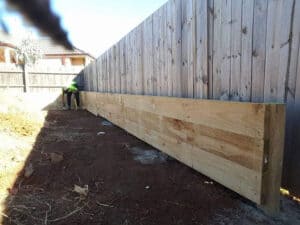Introduction
When it comes to fencing choices, homeowners typically find themselves at a crossroads. Selecting the right type of fence can be as daunting as choosing the best shade of paint for your living-room. Two popular options that regularly turn up in discussions are Colorbond fences and standard fencing. Each type has its own unique benefits and disadvantages, however which one genuinely rules supreme? In this article, we will start an adventurous journey through the landscape of fencing options to determine, at last, Colorbond Fences vs. Traditional Fencing: Which is Better?
Colorbond Fences: An Overview
What is a Colorbond Fence?
A Colorbond fence is a modern-day fencing service made from high-quality steel covered with a long lasting surface. It offers property owners a sleek look and remarkable durability. The charm lies not just in its visual appeal however likewise in its resilience versus harsh weather conditions.

Key Features of Colorbond Fencing
- Durability: Unlike wood or vinyl, Colorbond steel fences do not warp, rot, or rust. Variety of Colors: Available in numerous colors to complement any home design. Low Maintenance: Needs very little maintenance compared to traditional wood fences. Fire Resistance: Made from non-combustible products, providing safety benefits.
The Production Process
The production of Colorbond steel involves several steps:
Steel Coating: High-quality steel sheets are covered with zinc, followed by a layer of primer and an outside coat. Color Application: A last color coat offers both aesthetic appeal and UV protection.This meticulous procedure makes sure that each panel can hold up against the test of time while keeping its visual appeal.
Traditional Fencing: An Overview
What Constitutes Traditional Fencing?
Traditional fencing typically consists of wood or vinyl choices that have been used for decades. These materials use a traditional look but come with their own set of challenges.
Key Functions of Traditional Fences
- Natural Aesthetic: Wooden fences supply heat and mix seamlessly into natural landscapes. Customizable Designs: Can be integrated in various styles that show personal tastes. Eco-Friendly Options: Numerous wooden fences are sourced sustainably.
Common Materials Used
Wood: Cedar, pine, and redwood are popular options due to their natural appearance. Vinyl: Offers a more modern-day look while being resistant to fading and warping.Colorbond Fences vs. Conventional Fencing: Resilience Comparison
Lifespan of Colorbond vs. Wood
When thinking about sturdiness, there's no contest; Colorbond fences last longer than most conventional options by years. A well-installed https://parapetfencing.com.au/colorbond-fencing/ Colorbond fence can last over 30 years with very little maintenance, whereas wood fences usually need replacement every 10 to 15 years due to rot or insect damage.

Resistance to Weather Conditions
Weather Resistance Table
|Condition|Colorbond Fence|Conventional Wood Fence|| -------------------|-----------------|------------------------|| Rain|Outstanding|Poor (can rot)|| Sunlight|Exceptional|Moderate (can fade)|| Wind|Exceptional|Moderate (can break)|| Fire|Exceptional|Poor (flammable)|
As highlighted in this table, Colorbond's weather condition resistance makes it the exceptional choice for homes prone to adverse weather conditions.
Installation Process Comparison
How is Colorbond Fence Installation Done?
The installation of a Colorbond fence installation includes numerous crucial actions:
Preparation: Marking borders and clearing debris. Setting Posts: Setting up long lasting steel posts into concrete footings. Panel Installation: Attaching pre-made panels rapidly and easily.
Challenges in Installing Standard Fences
Installing traditional wooden or vinyl fences frequently requires more labor-intensive procedures:
Custom-cutting panels Ensuring posts are level Regular maintenance checks throughout installationThis intricacy can result in increased labor costs when working with a professional installer.
Cost Analysis Between Colorbond and Traditional Fencing
Initial Investment
While the initial cost for setting up a Colorbond fence may be higher than that of conventional wood or vinyl alternatives, it's vital to consider long-term savings due to less upkeep:
Cost Breakdown Table
|Type|Initial Expense Estimate|Upkeep Expense each year|| -------------------------|------------------------|---------------------------|| Colorbond Fence|$75 - $100 per meter|$20|| Conventional Wooden Fence|$60 - $80 per meter|$200|
As showed here, although you may pay more upfront for a Colorbond fence, your cost savings on maintenance expenses will stack up over time.
Aesthetic Appeal and Style Flexibility
Visual Impact of Colorbond Fences
With their sleek lines and contemporary surfaces, Colorbond fences use contemporary appeal fit for various architectural styles-- whether it's an urban loft or rural home.
Traditional Wood's Timeless Charm
On the other hand, nothing beats the traditional appeal that wooden fences bring to the table! Their ability to blend into natural surroundings makes them an enduring favorite amongst property owners looking for rustic aesthetics.
Environmental Considerations
Eco-Friendliness of Colorbond
Manufactured from recyclable products and needing little energy for maintenance purposes makes the Colorbond alternative eco-friendly!
Sustainability of Wood
Conversely, properly sourced wood can likewise be sustainable-- but keep in mind that ongoing treatments may include chemicals hazardous to nature!
FAQs About Colorbond Fences vs. Standard Fencing
Are Colorbond fences more costly than wood ones?
Yes; nevertheless, they need less maintenance gradually which offsets those preliminary costs.
How do I discover a credible Colorbond fence company?
Try to find regional evaluations online or ask neighbors who've had comparable installations done!
Can I install my own Colorbond fence?
While DIY is possible if you're handy enough-- working with specialists like a Colorbond fence contractor guarantees quality craftsmanship!
What colors are offered in the Colorbond range?
There's a comprehensive scheme readily available covering whatever from earthy tones to brilliant hues!
How frequently should I maintain my wood fence?
Frequently inspect every year; use preservatives every two years at minimum!
Do I need council approval for either type?
Always examine regional regulations prior; many areas have particular standards around height or materials used!
Conclusion
In conclusion, when weighing your choices for fencing services between Colorbond fences and standard options-- it becomes clear that each has its merits depending on individual choices! Nevertheless-- when considering toughness, low maintenance demands & & visual flexibility-- it's difficult not to lean towards Colorband as an impressive choice! Prepared to start? Consult with your regional Colorband fence installer today!